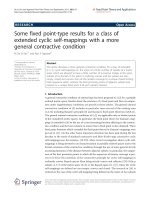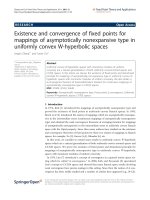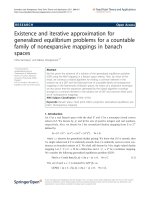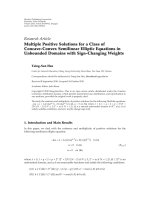Báo cáo hóa học: "EXISTENCE AND MULTIPLICITY OF SOLUTIONS FOR A CLASS OF SUPERLINEAR p-LAPLACIAN EQUATIONS" potx
Bạn đang xem bản rút gọn của tài liệu. Xem và tải ngay bản đầy đủ của tài liệu tại đây (537.44 KB, 12 trang )
EXISTENCE AND MULTIPLICITY OF SOLUTIONS FOR
A CLASS OF SUPERLINEAR p-LAPLACIAN EQUATIONS
JUAN WANG AND CHUN-LEI TANG
Received 16 May 2006; Revised 5 July 2006; Accepted 6 July 2006
By a variant version of mountain pass theorem, the existence and multiplicity of solu-
tions are obtained for a class of superlinear p-Laplacian equations:
−Δ
p
u = f (x,u). In
this paper, we suppose neither f satisfies the superquadratic condition in Ambrosetti-
Rabinowitz sense nor f (x,t)/
|t|
p−1
is nondecreasing with respect to |t|.
Copyright © 2006 J. Wang and C L. Tang. This is an open access article distributed un-
der the Creative Commons Attribution License, which permits unrestricted use, distri-
bution, and reproduction in any medium, provided the original work is properly cited.
1. Introduction and main results
In this paper, we consider the following superlinear p-Laplacian equations with Dirichlet
boundary value condition:
−
p
u = f (x,u), x ∈ Ω, u = 0, x ∈ ∂Ω, (1.1)
where
p
u is the p-Laplacian operator:
p
u = div(|∇u|
p−2
∇u)withp>1, Ω is a bound-
ed domain in R
N
(N ≥ 1) with smooth boundary ∂Ω, f ∈ C(Ω × R,R) is subcritical in t,
that is, there is a q
∈ (p,np/(n − p)) when N>p; q ∈ (p,+∞)whenN ≤ p such that
lim
t→∞
f (x, t)
|t|
q−1
= 0 (1.2)
uniformly in a.e. x
∈ Ω. We are interested in the case that f is superlinear in t at infinity,
that is,
lim
|t|→∞
f (x, t)t
|t|
p
= +∞. (1.3)
Ambrosetti and Rabinowitz have got the solutions of problem ( 1.1) by a very famous
mountain pass theorem in [1]. But they supposed the well-known (AR) condition holds,
Hindawi Publishing Corporation
Boundary Value Problems
Volume 2006, Article ID 47275, Pages 1–12
DOI 10.1155/BVP/2006/47275
2 A class of superlinear p-Laplacian equations
that is, for some μ>p, M>0,
0 <μF(x, s)
≤ f (x,s)s ∀|s|≥M, x ∈ Ω. (AR)
It is easy to see that the (AR) implies (1.3). This (AR) condition usually plays a very im-
portant role in verifying that the functional corresponding to problem has a Mountain-
Pass geometr y and shows that a related (PS)
c
sequence is bounded (see [1, 2, 5, 12]). But
there are always many functions that do not satisfy (AR) condition. Many efforts have
been made to overcome the difficulties brought by the absence of the (AR) (see [3, 6, 8 –
11, 14, 15, 18–20]). To the authors’ knowledge, the following Assumption 1.1 is widely
used (see [8, 18–20]).
Assumption 1.1. f (x, t)/
|t|
p−1
is nondecreasing with respect to |t|.
In this paper, we will get the existence of at least two nontrivial solutions of problem
(1.1) where the nonlinearity f (x,t) satisfies neither the classic (AR)norAssumption 1.1,
instead, we suppose that an assumption weaker than Assumption 1.1 holds.
Assumption 1.2. There exists θ
≥ 1suchthatθG(x, t) ≥ G(x,st)forallx ∈ Ω, t ∈ R,and
s
∈ [0,1], where G(x,t) = f (x,t)t − pF(x, t)andF(x,t) =
t
0
f (x, s)ds.
Then our main results are the following two theorems.
Theorem 1.3. Suppose f (x,t) is subcritical in t and satisfies Assumption 1.2 and the fol-
lowing conditions hold:
(f1) f (x,t)
≥ 0 for all t ≥ 0, x ∈ Ω and f (x,t) ≡ 0 for all t ≤ 0, x ∈ Ω;
(f2) limsup
t→0
+
( f (x, t)/t
p−1
) = a(x) and lim
t→+∞
( f (x, t)/t
p−1
) = +∞ uniformly in a.e.
x
∈ Ω,wherea ∈ L
∞
(Ω) satisfies a(x) ≤ λ
1
for all x ∈ Ω and a(x) <λ
1
on some
Ω
⊂ Ω with |Ω
| > 0, λ
1
is the first eigenvalue of −Δ
p
and |Ω
| is the measure of Ω
.
Then problem (1.1) has at least one solution u>0.
If we consider a more general situation, we can get the following theorem.
Theorem 1.4. Suppose f (x,t) is subcritical in t and satisfies Assumption 1.2 and the fol-
lowing conditions hold:
(f3) f (x,t)t
≥ 0 for all t ∈ R, x ∈ Ω;
(f4) limsup
t→0
( f (x, t)t/|t|
p
) = c(x) and lim
|t|→∞
( f (x, t)t/|t|
p
) = +∞ uniformly in a.e.
x
∈ Ω,wherec ∈ L
∞
(Ω) satisfies c(x) ≤ λ
1
for all x ∈ Ω and c(x) <λ
1
on some
Ω
0
⊂ Ω with |Ω
0
| > 0.
Then problem (1.1) has at least two nont rivial solutions in which one is positive and
the other is negative.
Remark 1.5. Assumption 1.2 was first introduced by Jeanjean in [6]forp
= 2, and re-
cently by Liu and Li in [9]forgeneralp>1. We can easily prove that Assumption 1.2 is
equivalent to Assumption 1.1 when θ
= 1andAssumption 1.2 gives some general sense
of monotony when θ>1. Liu and Li in [9] has proved that Assumption 1.1 implies
Assumption 1.2 when p>1. Moreover, we can find some examples that satisfy Assumption
1.2 but not Assumption 1.1.
J. Wang and C L. Tang 3
Example 1.6. Set p
= 2,
f (x, t)
= 5t ln
1+t
2
+ 9sint, (1.4)
it follows that
G(x,t)
= 9(t sint +2cost − 2) + 5
t
2
− ln
1+t
2
. (1.5)
Let θ
= 100, we can prove by some simple computation that G satisfies Assumption 1.2
but does not satisfy Assumption 1.1 any more.
Remark 1.7. We only consider the solutions of problem (1.1) in superlinear case. Recently,
Zhou has got a positive solution of problem (1.1)forp
= 2in[18] (see [18,Corollary
2.3]) and [19] (see [19, Theorem 1.2]). Then Li and Zhou extend the results to p>1in
[8] (see [8, Remark 1.2]). But in their discussion, they suppose (f1), Assumption 1.1,and
the following condition hold:
(f5) lim
t→0
+
( f (x, t)/t
p−1
) = p(x)andlim
t→+∞
( f (x, t)/t
p−1
) = +∞ uniformly in a.e. x ∈
Ω,wherep(x) ≡ l ∈ [0,λ
1
) (in [8, 18]) or p ∈ L
∞
(Ω)withp
∞
<λ
1
(in [19]).
We can see that we extend the results of [8, 18, 19] in superlinear case on two hands.
On one hand, our condition (f2) is weaker than (f5), we do not need lim
t→0
+
( f (x, t)/t
p−1
)
exist but only suppose limsup
t→0
+
( f (x, t)/t
p−1
) = a(x) ≤ λ
1
and a(x) <λ
1
on some Ω
⊂
Ω with positive measure, so we extend the range of the nonlinearity largely. On the other
hand, from Remark 1.5 we can see that our Assumption 1.2 is weaker than Assumption
1.1 and we believe that Assumption 1.2 can take the place of Assumption 1.1 in many
discussions of superlinear p-Laplacian problem. So our results are even new when p
= 2,
we extend the results of [8, 18, 19] in superlinear case for general p>1.
Remark 1.8. Liu and Li in [9] has got infinitely many solutions of problem (1.1)bythe
fountain theorem. But in their discussion, they supposed that f (x,t)isoddwithrespect
to t. In our discussion, we do not suppose f (x, t) is odd any more. We will get the existence
and multiplicity of solutions for problem (1.1) by a variant version of mountain pass
theorem (introduced in [13]andusedin[4], see also Lemma 2.1). So our results are
different from those in [9].
Remark 1.9. Schechter and Zou have got a nontrivial solution of problem (1.1)forp
= 2
in [14] under the following superquadratic conditions (a
1
) together with (a
2
)or(a
2
):
(a
1
) either
F(x,t)
t
2
−→ ∞ as t −→ ∞ , (1.6)
or
F(x,t)
t
2
−→ ∞ as t −→ − ∞ ; (1.7)
(a
2
) there are constants μ
1
> 2, r>0, and C>0suchthat
μ
1
F(x,t) − tf(x,t) ≤ C
t
2
+1
, |t|≥r; (1.8)
(a
2
) the function G(x,t) = f (x,t)t − 2F(x, t)isconvexint.
4 A class of superlinear p-Laplacian equations
It is easy to see that the function f in Example 1.6 satisfies our Assumption 1.2 and
(a
1
), but not satisfies (a
2
)nor(a
2
). In fact, if G(x,t) > 0forallt = 0, we can get
Assumption 1.2 from (a
1
)and(a
2
). So our results are different from those of [14].
2. Some important lemmas
To look for a nontrivial solution of (1.1), we need the following version of the mountain
pass theorem.
Lemma 2.1 (Schechter [13]). Let E be a real Banach space with its dual space E
∗
and sup-
pose that J
∈ C
1
(E,R) satisfies the condition
max
J(0), J
u
1
≤
α<β≤ inf
u=ρ
J(u) (2.1)
for some α<β, ρ>0 and u
1
∈ E with u
1
>ρ.Letc be characterized by
c
= inf
γ∈Γ
max
0≤τ≤1
J
γ(τ)
, (2.2)
where Γ
={γ ∈ C([0,1],E):γ(0) = 0; γ(1) = u
1
} is the set of continuous paths joining 0
and u
1
. Then there exists a sequence {u
n
}⊂E such that
J
u
n
−→
c ≥ β (n −→ +∞),
1+
u
n
J
u
n
E
∗
−→ 0(n −→ +∞).
(2.3)
In the proof of the theorems we will use the following lemma to prove the geometric
condition of the mountain pass theorem.
Lemma 2.2. If (f2) holds, there exits a positive constant α<1 such that
Ω
a(x)|u|
p
dx < α
Ω
|∇u|
p
dx (2.4)
for all u
∈ W
1,p
0
(Ω).
Proof. Let us prove it by contradiction. Otherwise, there exists a sequence
{u
n
}⊂W
1,p
0
(Ω)
such that
Ω
a(x)
u
n
p
dx ≥
1 −
1
n
Ω
∇
u
n
p
dx. (2.5)
Set v
n
= u
n
/u
n
, it follows that
Ω
a(x)
v
n
p
dx ≥ 1 −
1
n
. (2.6)
Then by (f2) and the Poincare inequality, we have
Ω
a(x)
v
n
p
dx ≤ λ
1
Ω
v
n
p
dx ≤
Ω
∇
v
n
p
dx =
v
n
p
= 1. (2.7)
J. Wang and C L. Tang 5
Therefore, we obtain
1
−
1
n
≤
Ω
a(x)
v
n
p
dx ≤ λ
1
Ω
v
n
p
dx ≤
Ω
∇
v
n
p
dx = 1. (2.8)
For
{v
n
} is bounded in W
1,p
0
(Ω), then there exists v ∈ W
1,p
0
(Ω)suchthat
v
n
v weakly in W
1,p
0
(Ω),
v
n
−→ v in L
p
(Ω).
(2.9)
Let n
→∞in (2.8), one gets
λ
1
Ω
|v|
p
dx = lim
n→∞
Ω
∇
v
n
p
dx = 1, (2.10)
Ω
a(x) − λ
1
|
v|
p
dx = 0. (2.11)
By (2.10), the weakly lower semicontinuity of
·
p
and the Poincare inequality we have
1
= liminf
n→∞
Ω
∇
v
n
p
dx ≥
Ω
|∇v|
p
dx ≥ λ
1
Ω
|v|
p
dx = 1, (2.12)
it follows that
λ
1
Ω
|v|
p
dx =
Ω
|∇v|
p
dx = 1. (2.13)
From (2.13), we can see that v is in fact the eigenfunction corresponding to the first
eigenvalue of the following problem:
−
p
u = λ|u|
p−2
u. (2.14)
Then from the results for p-Laplacian, we have v
= 0, so (2.11) implies that a(x) = λ
1
a.e.
on Ω, but this is impossible by (f2). Hence, Lemma 2.2 holds.
To see that a nonnegative solution of problem (1.1) is in fact a positive solution in Ω,
we need the following strong maximum principle for p-Laplacian.
Lemma 2.3 ( V
´
azquez [17]). Let u ∈C
1
(Ω) be such that
p
u ∈ L
2
loc
(Ω), u ≥ 0 a.e. on Ω,
p
u ≤ β(u) a.e. with β :[0,∞] → R continuous nondecreasing, β(0) = 0 and either β(s) = 0
for some s>0 or β(s) > 0 for all s>0,but
1
0
j(s)
−1/p
ds =∞, where j(s) =
s
0
β(t)dt, (2.15)
holds. Then if u does not vanish identically of Ω, it is positive everywhere in Ω.
6 A class of superlinear p-Laplacian equations
3.Proofofthetheorems
Proof of Theorem 1.3. It is well known that to seek a nontrivial weak solution of problem
(1.1) is equivalent to finding a nonzero critical point of the C
1
-function:
J(u)
=
1
p
Ω
|∇u|
p
dx −
Ω
F(x,u)dx. (3.1)
In the following proof, we will find the critical points of J(u) in three steps.
Step 1. There exist some ρ,β>0, such that J(u)
≥ β for all u ∈ W
1,p
0
(Ω)withu=ρ.
In fact, by Lemma 2.2,letε>0 be small enough such that α + ε/λ
1
< 1. Since f (x, t)is
subcritical and (f2) holds, there exist δ
1
,δ
2
> 0andM>0fortheaboveε,suchthat
F(x,s)
≤
1
p
a(x)+ε
|
s|
p
∀|s| <δ
1
, x ∈ Ω,
F(x,s)
≤
1
p
ε
|s|
q
∀|s| >δ
2
, x ∈ Ω,
F(x,s)
≤ M|s|
p
≤
M
δ
q−p
1
|s|
q
∀δ
1
≤|s|≤δ
2
, x ∈ Ω,
(3.2)
where q isthesameasin(1.2). Set A
= max{(1/p)ε,M/δ
q−p
1
} > 0, then we have
F(x,s)
≤
1
p
a(x)+ε
|
s|
p
+ A|s|
q
(3.3)
for all (x,s)
∈ Ω × R. By the Poincare inequality and Sobolev inequality, one obtains
J(u)
≥
1
p
u
p
−
1
p
Ω
a(x)+ε
|
u|
p
dx − A
Ω
|u|
q
dx
≥
1
p
u
p
−
1
p
Ω
α +
ε
λ
1
|∇
u|
p
dx − Cu
q
=
1
p
1 − α −
ε
λ
1
u
p
− Cu
q
,
(3.4)
where C>0 is a constant. Since 1
− α − ε/λ
1
> 0andp<q,letρ be small enough such
that
β
=
1
p
1 − α −
ε
λ
1
ρ
p
− Cρ
q
> 0, (3.5)
so we have J
|
∂B
ρ
≥ β>0.
Step 2. There exists e
∈ W
1,p
0
(Ω)withe >ρsuch that J(e) < 0.
Since lim
t→+∞
( f (x, t)/t
p−1
) = +∞ by (f2), then for any ε>0, there exists M>0such
that f ( x, t)/t
p−1
≥ 1/ε for all t>Mand x ∈ Ω.Setc(ε) = (1/ε)M
p−1
, consequently,
f (x, t)
≥
1
ε
t
p−1
− c(ε) (3.6)
J. Wang and C L. Tang 7
for all t
≥ 0andx ∈ Ω, which implies that
f (x, st)t
≥
1
ε
s
p−1
t
p
− c(ε)t (3.7)
for all x
∈ Ω, t ≥ 0, and 0 ≤ s ≤ 1. Integrating both sides of the inequality (3.7) on [0,1]
with respect to s,weobtain
F(x,t)
≥
1
pε
t
p
− c(ε)t (3.8)
for all t
≥ 0. It follows from (3.8)that
F
x, tϕ
1
≥
1
pε
t
p
ϕ
p
1
− c(ε)tϕ
1
. (3.9)
Dividing by t
p
,onehas
F
x, tϕ
1
t
p
≥
1
pε
ϕ
p
1
−
c(ε)ϕ
1
t
p−1
, (3.10)
thus we have
Ω
F
x, tϕ
1
t
p
dx ≥
Ω
1
pε
ϕ
p
1
−
c(ε)ϕ
1
t
p−1
dx. (3.11)
Let t
→∞in (3.11), it follows that
liminf
t→+∞
Ω
F
x, tϕ
1
t
p
dx ≥
Ω
1
pε
ϕ
p
1
dx (3.12)
for all ε>0. For ε>0isarbitrary,letε
→ 0, then one obtains
lim
t→+∞
Ω
F
x, tϕ
1
t
p
dx = +∞. (3.13)
Consequently,
J
tϕ
1
t
p
=
1
p
ϕ
1
p
−
Ω
F
x, tϕ
1
t
p
dx −→ − ∞ (t −→ +∞). (3.14)
Hence, let t
0
be big enough and e = t
0
ϕ
1
,thenwehaveJ(e) < 0.
Define
Γ
=
γ ∈ C
[0,1],W
1,p
0
(Ω)
: γ(0) = 0; γ(1) = e
, c = inf
γ∈Γ
max
0≤τ≤1
γ(τ)
,
(3.15)
then c
≥ β>0. By Lemma 2.1, there exists a sequence {u
n
}⊂W
1,p
0
(Ω), such that
J
u
n
=
1
p
Ω
∇
u
n
p
dx −
Ω
F
x, u
n
dx −→ c (n −→ ∞ ), (3.16)
1+
u
n
J
u
n
−→
0(n −→ ∞ ). (3.17)
8 A class of superlinear p-Laplacian equations
Combining (3.16)and(3.17), we obtain
Ω
1
p
f
x, u
n
u
n
− F
x, u
n
dx = c + o(1). (3.18)
Step 3. Let us prove that the sequence
{u
n
} is bounded.
Otherwise, there is a subsequence of
{u
n
} (still denoted by {u
n
}) satisfying u
n
→∞
as n →∞.Setw
n
= u
n
/u
n
,thenw
n
is bounded. So we may assume that for some w ∈
W
1,p
0
(Ω) there is a subsequence of {w
n
} (still denoted by {w
n
})suchthat
w
n
w weakly in W
1,p
0
(Ω),
w
n
−→ w in L
r
(Ω)
1 ≤ r<p
∗
,
w
n
(x) −→ w(x)a.e.x ∈ Ω,
(3.19)
as n
→∞. It is easy to see that w
+
n
and w
−
n
have the same convergence which is similar to
(3.19)whereu
+
= max{u,0} and u
−
= min{u,0} for u ∈ W
1,p
0
(Ω).
On one hand, we claim that w
+
≡ 0. Otherwise, set Ω
1
={x ∈ Ω : w
+
(x) = 0}, Ω
2
=
{
x ∈ Ω : w
+
(x) > 0}.Sinceu
n
→+∞,wehaveu
+
n
→ +∞ as n →∞for a.e. x ∈ Ω
2
.Since
lim
t→+∞
f (x, t)
|t|
p−1
= +∞, (3.20)
we have
lim
n→+∞
f
x, u
+
n
u
+
n
p−1
= +∞ a.e. on Ω
2
. (3.21)
If
|Ω
2
| > 0, one obtains
o(1)
=
J
u
n
,u
n
=
Ω
∇
u
n
p
dx −
Ω
f
x, u
n
u
n
dx
≤
u
n
p
−
Ω
2
f
x, u
+
n
u
+
n
dx =
u
n
p
1 −
Ω
2
f
x, u
+
n
u
+
n
p−1
w
+
n
p
dx.
(3.22)
So it follows that
o(1)
≤ 1 −
Ω
2
f
x, u
+
n
u
+
n
u
+
n
p−1
w
+
n
p
dx. (3.23)
By Fatou’s lemma, we have
1
≥ liminf
n→∞
Ω
2
f
x, u
+
n
u
+
n
p−1
w
+
n
p
dx = +∞, (3.24)
which is a contradiction, so
|Ω
2
|=0andw
+
≡ 0.
J. Wang and C L. Tang 9
On the other hand, if w
+
≡ 0, set a sequence {t
n
} of real numbers such that J(t
n
u
n
) =
max
t∈[0,1]
J(tu
n
). For any integer m>0, set w
m
n
= (2pm)
1/p
w
n
. By (f2), (3.3), and the con-
vergence of w
+
n
,onehas
limsup
n→∞
Ω
F
x, w
m
n
dx = limsup
n→∞
Ω
F
x,(2pm)
1/p
w
+
n
dx
≤ limsup
n→∞
Ω
2m
λ
1
+ ε
w
+
n
p
dx +
Ω
A(2pm)
q/p
(w
+
n
)
q
dx
=
limsup
n→∞
C
1
w
+
n
p
p
+ C
2
w
+
n
q
q
=
C
1
w
+
p
p
+ C
2
w
+
q
q
= 0,
(3.25)
where C
1
,C
2
> 0 are constants. Since u
n
→+∞ as n →∞,onehas0≤ (2pm)
1/p
/u
n
≤
1whenn is big enough. By the definition of t
n
,weobtain
J
t
n
u
n
≥
J
w
m
n
≥
2m −
Ω
F
x, w
m
n
dx ≥ m, (3.26)
which implies that
J
t
n
u
n
→
+∞ (n −→ ∞ ). (3.27)
Noting that J(0)
= 0andJ(u
n
) → c,so0<t
n
< 1whenn is big enough. It follows that
Ω
∇
t
n
u
n
p
dx −
Ω
f
x, t
n
u
n
t
n
u
n
dx =
J
t
n
u
n
,t
n
u
n
=
t
n
dJ
tu
n
dt
t=t
n
= 0.
(3.28)
But for 0
≤ t
n
≤ 1, we have θG(x,u
n
) ≥ G(x,t
n
u
n
)byAssumption 1.2,then(3.27)and
(3.28)implythat
Ω
1
p
f
x, u
n
u
n
− F
x, u
n
dx =
1
p
Ω
G
x, u
n
dx ≥
1
pθ
Ω
G
x, t
n
u
n
dx
=
1
θ
Ω
1
p
f
x, t
n
u
n
t
n
u
n
− F
x, t
n
u
n
dx
=
1
θ
Ω
1
p
∇
t
n
u
n
p
− F
x, t
n
u
n
dx
=
1
θ
J
t
n
u
n
−→
+∞ (n −→ ∞ ).
(3.29)
which contradicts (3.18), so
{u
n
} is bounded.
10 A class of superlinear p-Laplacian equations
By the compactness of Sobolev embedding and the standard procedures, we know that
{u
n
} has a subsequence which converges to a weak solution u ∈ W
1,p
0
(Ω)of(1.1). By (f1),
we must have u
≥ 0. By the regularity results of Ladyzhenskaya and Ural’tseva (see [7]),
u
∈ L
∞
and hence u ∈ C
1,α
loc
(Ω) ⊂ C
1
(Ω) (see [16]). Since u ∈ L
∞
(Ω), it is easy to see that
p
u =−f (x,u) ∈ L
2
loc
(Ω). Moreover, we have − f (x,u) ≤ 0 by (f1). Hence by Lemma 2.3
with β(u)
= 0, one has u>0a.e.onΩ.ThenTheorem 1.3 is proved.
Proof of Theorem 1.4. First, let us consider the following truncated problem:
−
p
u = f
1
(x, u), x ∈ Ω, u = 0, x ∈ ∂Ω, (3.30)
where
f
1
(x, t) =
⎧
⎨
⎩
f (x, t), t ≥ 0,
0, t
≤ 0.
(3.31)
For this problem (3.30), it is easy to see that f
1
(x, t) satisfies the conditions of Theorem
1.3.SobyTheorem 1.3, there is a positive solution u>0ofproblem(3.30) and it is also a
solution of problem (1.1) by the definition of f
1
.
Next, let us see another truncated problem:
−
p
u = f
2
(x, u), x ∈ Ω, u = 0, x ∈ ∂Ω, (3.32)
where
f
2
(x, t) =
⎧
⎨
⎩
f (x, t), t ≤ 0,
0, t
≥ 0.
(3.33)
In order to find a solution of problem (3.32), set v
=−u, g(x,t) =−f
2
(x, −t), then
problem (3.32) is equivalent to the following problem:
−
p
v = g(x,v), x ∈ Ω, v = 0, x ∈ ∂Ω. (3.34)
It is easy to see that if v is a solution of problem (3.34), then u
=−v is a solution of
problem (3.32). Since f (x,t) satisfies the conditions in Theorem 1.4, g(x, t) satisfies all
the conditions in Theorem 1.3.ThenbyTheorem 1.3, there is a positive solution v>0of
problem (3.34), so u
=−v<0isasolutiontoproblem(3.32) and it is also a solution of
problem (1.1).
From the above discussion, we can deduce that there exist at least a positive solution
and a negative solution of problem (1.1). Then problem (1.1) has at least two nontrivial
solutions.
J. Wang and C L. Tang 11
Acknowledgments
The authors would like to thank the referee for valuable suggestions. This work was sup-
ported by National Natural Science Foundation of China (No. 10471113) and by the
Teaching and Research Award Program for Outstanding Young Teachers in Higher Ed-
ucation Institutions of MOE, China.
References
[1] A. Ambrosetti and P. H. Rabinowitz, Dual variational methods in critical point theory and appli-
cations, Journal of Functional Analysis 14 (1973), no. 4, 349–381.
[2] H. Br
´
ezis and L. Nirenberg, Positive solutions of nonlinear elliptic equations involving critical
Sobolev exponents, Communications on Pure and Applied Mathematics 36 (1983), no. 4, 437–
477.
[3] D.G.CostaandC.A.Magalh
˜
aes, Variational elliptic problems which are nonquadratic at infinity,
Nonlinear Analysis 23 (1994), no. 11, 1401–1412.
[4] D. G. Costa and O. H. Miyagaki, Nontrivial s olutions for perturbations of the p-Laplacian on
unbounded domains, Journal of Mathematical Analysis and Applications 193 (1995), no. 3, 737–
755.
[5] J. V. Goncalves and S. Meira, On a class of semilinear elliptic problems near critical growth, Inter-
national Journal of Mathematics and Mathematical Sciences 21 (1998), no. 2, 321–330.
[6] L. Jeanjean, On the existence of bounded Palais-Smale sequences and application to a Landesman-
Lazer-type problem set on R
N
, Proceedings of the Royal Society of Edinburgh. Section A. Mathe-
matics 129 (1999), no. 4, 787–809.
[7] O.A.LadyzhenskayaandN.N.Ural’tseva,Linear and Quasilinear Elliptic Equations,Academic
Press, New York, 1968.
[8] G. Li and H S. Zhou, Asymptotically linear Dirichlet problem for t he p-Laplacian, Nonlinear
Analysis, Series A: Theory Methods 43 (2001), no. 8, 1043–1055.
[9] S.B.LiuandS.J.Li,Infinitely many solutions for a superlinear elliptic equation,ActaMathematica
Sinica 46 (2003), no. 4, 625–630 (Chinese).
[10] K. Perera and M. Schechter, Se milinear elliptic equations having asymptotic limits at zero and
infinity, Abstract and Applied Analysis 4 (1999), no. 4, 231–242.
[11] A. Qian, Existence of infinitely many nodal solutions for a superlinear Neumann boundary value
problem, Boundary Value Problems (2005), no. 3, 329–335.
[12] P. H. Rabinowitz, Minimax methods and their application to partial differential equations,Sem-
inar on Nonlinear Partial Differential Equations (Berkeley, Calif, 1983), Math. Sci. Res. Inst.
Publ., vol. 2, Springer, New York, 1984, pp. 307–320.
[13] M. Schechter, A variation of the mountain pass lemma and applicat ions, Journal of the London
Mathematical Societ y. Second Series 44 (1991), no. 3, 491–502.
[14] M. Schechter and W. Zou, Superlinear problems, Pacific Journal of Mathematics 214 (2004),
no. 1, 145–160.
[15] A. Szulkin and W. Zou, Homoclinic orbits for asymptotically linear Hamiltonian systems,Journal
of Functional Analysis 187 (2001), no. 1, 25–41.
[16] P. Tolksdorf, Regularity for a more general class of quasilinear elliptic equations,JournalofDiffer-
ential Equations 51 (1984), no. 1, 126–150.
[17] J. L. V
´
azquez, A strong maximum principle for some quasilinear elliptic equations,AppliedMath-
ematics and Optimization 12 (1984), no. 3, 191–202.
[18] H S. Zhou, Existence of asymptotically linear Dirichlet problem, Nonlinear Analysis. Series A:
Theory and Methods 44 (2001), no. 7, 909–918.
12 A class of superlinear p-Laplacian equations
[19] , An application of a mountain pass theorem, Acta Mathematica Sinica 18 (2002), no. 1,
27–36.
[20] W. Zou, Variant fountain theorems and their applications, Manuscripta Mathematica 104 (2001),
no. 3, 343–358.
Juan Wang: Department of Mathematics, School of Mathematics and Statistics,
Southwest University, Chongqing 400715, China
E-mail address:
Chun-Lei Tang: Department of Mathematics, School of Mathematics and Statistics,
Southwest University, Chongqing 400715, China
E-mail address:









